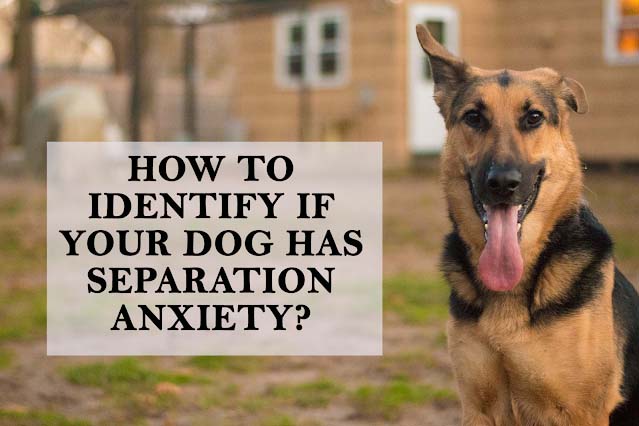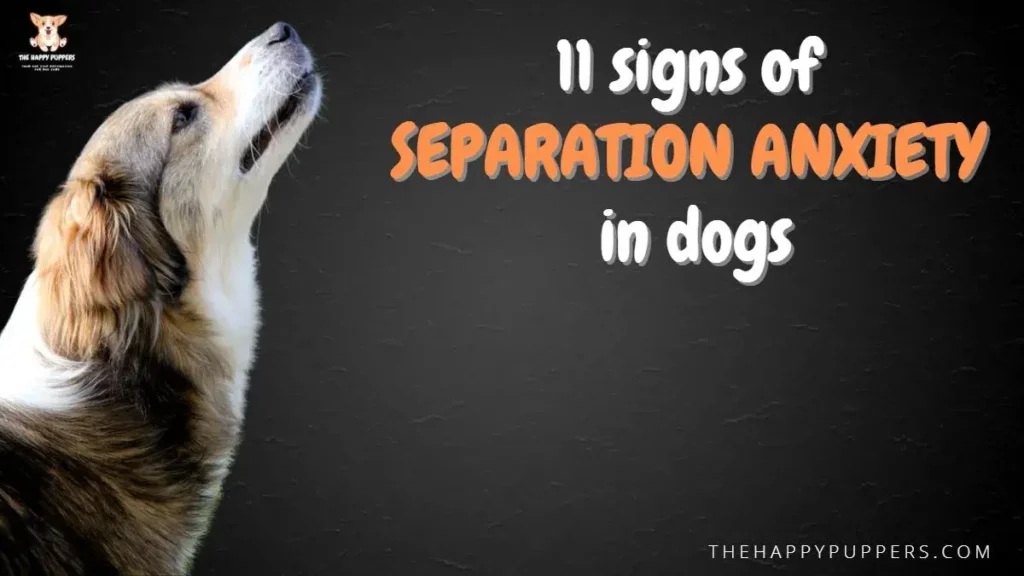Topics covered in this blog post
Symptoms of separation anxiety in dogs
One of the most widely heard complaints of dog caretakers is that their dog is an angel in the presence of his or her guardians but turns into the devil when left alone. Their dogs might howl, defecate, urinate, chew, barf, dig or finally try to escape. These behavioral issues indicate that the dog not only needs better house training but might also be suffering from separation anxiety. If your dog’s problems are accompanied by other behaviors like showing anxiety or clinginess when you prepare to go out, these are indicative towards your dog suffering from separation anxiety and not that your dog is not properly house trained. Simulation anxiety gets resort in dogs when they become upset due to being away from their guardians. If a dog suffering from separation anxiety tries to escape, it is extreme and might result in house destruction and self injury.

Anxious dogs might display different kinds of behavior when their parents are getting ready to leave. Some might become agitated while others might become depressed or anxious before their guardians depart. Some would even try to prevent their parents from leaving the house at all.
The moment their guardians leave, such dogs would begin howling, barking and displaying other stress related behaviors within a very short time, usually minutes. When the guardian comes back, the dog will greet him or her like he hasn’t seen his parent in ages.
The purpose of treating a dog who is suffering from separation anxiety is to resolve the underlying anxiety by reprogramming the dogs brain to enjoy, or at least be tolerant with being left alone. This kind of behavior modification can be achieved by setting up an environment which provokes the distress without experiencing any kind of anxiety or fear.
Before you start reprogramming your dogs behavior, you need to know the reasons behind separation anxiety in dogs.
Causes of separation anxiety
So far there has been no concrete evidence to indicate why exactly do dogs develop separation anxiety. However, observation of dogs coming from different environments have indicated that this kind of a behavior problem is more often observed in dogs who were adopted from shelters than the ones who were living with a single family from the time of puppyhood. The following situations are most likely to trigger separation anxiety in dogs:
Change of family or guardian
Being surrendered to a shelter or abandoned or suddenly been given to a new family or guardian can trigger separation anxiety. Since such dogs don’t understand why they are being sent away it causes a lot of stress on them.
Change in schedule
Dogs are used to a specific schedule. If there is a sudden change in the schedule specifically in terms of when they are left alone, it can lead to the development of separation anxiety. For example, you were with your dog for the past four months due to the lock down. Your dog saw you 24/7. Now suddenly you have to go back to your job and your dog is left alone for 6 to 7 hours. Such a change might lead to development of separation anxiety in your dog.
Residence change
Dogs don’t like change of environment suddenly. A change in residence can trigger separation anxiety.
Change in the household members
The sudden absence of a family member or you moving away can trigger separation anxiety.
Now that you know the reasons behind separation anxiety in dogs, the next thing to know are the symptoms your dogs is likely to display if he/she is suffering from separation anxiety.
Symptoms of separation anxiety in dogs
Barking and howling
A dog who suffers from separation anxiety might immediately start barking or howling when left alone or is separated from his or her guardian. Howling or barking which stems from separation anxiety is persistent and does not seem to be triggered by anything else except the fear of being alone.
Urinating and defecating
If your dog urinates or defecates in your presence, he or she most likely needs better house training. However if this behavior always gets manifested in your absence, then your dog is most likely suffering from separation anxiety.
Chewing digging and destruction
Some dogs suffering from separation anxiety tend to chew on objects like windowsills or door frames. They will try to dig at the doorways and the doors and destroy the house furniture. Such behaviors can cause harm to your dog. Your dog may land up with script paws, damaged nails or broken teeth. In a few severe cases dogs have tried to escape through the window and got impaled by the broken glass of the windows. If this behavior is not caused by separation anxiety, this may be exhibited even when the guardians are around.
Pacing
Some dogs will trot on a fixed spot in a fixed pattern when they’re alone or separated from their guardians. The spacing behavior can either be in circular pattern or it can be back and forth in a straight line. Similar to the chewing and digging behavior, if this behavior is triggered from separation anxiety, it will not be observed when the dog guardians are present.
Coprophagia
Coprophagia is the behavioral disorder when the dogs defecate and consume some or all of the excrement. If this behavior is performed in the absence of the guardians, then it most likely is stemming from separation anxiety.
Escaping behavior
If your dog has separation anxiety, there is more than likely chance that your dog will try to escape from the house to search for you. The escaping behavior further increases if the dog is confined. Your bubble tried to chew through or dig through any thing in his way he retired this can lead to infliction of self injury like cut and scrapes, damaged nails etc. This behavior will specifically be seen when the guardian is not around.
Behavioral problems to rule out
Sometimes it is hard to understand whether the inappropriate behavior displayed by the dog is due to separation anxiety or not. A few of the behavioral problems can lead to similar symptoms. Before reaching to the conclusion that your dog is suffering from separation anxiety, it is important that you rule out the following behavioral problems:
Incomplete house training
If your dog is constantly urinating in the house, even in your presence, he or she is most likely incompletely house trained. Your dog’s house training was either incomplete or it involves punishment.
Urine marking
Some dogs will urinate in the house as a part of marking the house with her scent. Dogs are territorial creatures. They use scent to market their territory. If your dog is lifting a leg to urinate, he or she is most likely marking his or her territory.
Boredom
Dogs get bored very easily and need constant mental stimulation. Some dogs can become disruptive when left alone. These dogs don’t appear to be anxious otherwise.
Juvenile destruction
Dogs are known to chew everything in their sight during their puppynhood stages. This behavior will be displayed in front of the guardians as well as when they are away.
Excessive howling or barking
There are certain breeds of dogs who are known to bark more than others. Some dogs also however bark in response to various stimulants present in the environment like unfamiliar sounds, sights, sirens etc. They would vocalize their happiness when their guardians come home and their distress when their guardians are away.
Curing separation anxiety
Separation anxiety is not a lifelong problem. It can easily be cured. To cure separation anxiety in dogs, you must employ counter conditioning and desensitization methods. Counterconditioning focuses on redirecting the brain of the pup toward more enjoyable activities. If your pup has enough things to do when you are at work or not at home, it is less likely that your pup will feel anxious in your absence.
If you are hard finding it hard to deal with separation anxiety on your own, you can enlist the help of a dog trainer or dog behaviorist. Alternatively, you can also enroll your dog in doggy daycare. This way, when you are out, you can leave your dog at the daycare so that your dog will have company and will not get bored or feel stressed out.
What do not do?
If you are struggling with separation anxiety, scolding, hitting or punishing your dog is not going to move the problem. The first thing that you need to understand is separation anxiety. The reason your dog is showing signs of separation anxiety is because he is upset and in distress. If you decide to punish your dog, it might just increase his distress and instead of reducing it. Therefore, punishing your dog is not the right way to tackle the problem period
Conclusion
Now that you know the common symptoms of dog anxiety, have you noticed your dog display any of the above-mentioned symptoms? If yes, what did you to about it? There are many ways to treat separation anxiety in dogs. The best way is behavioral reprogramming so that your dog understands that it’s all right to be left alone.
If you found this post insightful, please subscribe to The Happy Puppers. Your subscription will allow me to notify you about the release of any new blog posts. This way, you can say updated in the latest chapters and tricks of dog care. If you like watching videos, subscribe to the YouTube channel of The Happy Puppers, Shruti and Delta. Do not forget to ring the notification bell. If you want me to answer your questions live, you can find me on Twitch. I host co-working streams every Tuesday to Sunday 11:00 AM to 7:00 PM Indian Standard Time. You can ask your questions directly on twitch or you can find me on social media. Alternatively you can also leave your questions in the comment section below. I will be happy to help
See you in my next post.
Dr. Shruti

